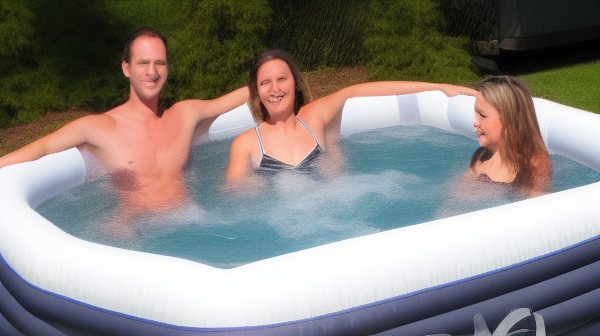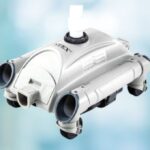IN THIS ARTICLE
Unveiling the ultimate showdown: Inflatable hot tub vs regular hot tub – which one reigns supreme in the realm of relaxation?
IStep into the world of hot tubs as we dissect the contrasting features of inflatable hot tubs and regular hot tubs.
Delving into their unique attributes and advantages, we navigate the path to finding your ideal soak sanctuary.
Join us on this journey as we weigh the pros and cons of these two titans, empowering you to make an enlightened choice for your ultimate rejuvenation experience
The Pros and Cons of Inflatable Hot Tubs: A Relaxing Soak or a Burst Bubble?
Inflatable hot tubs have been gaining popularity among those seeking a luxurious and convenient way to unwind and indulge in the comfort of warm water therapy.
With their affordability, ease of setup, and portability, these portable spas have emerged as a viable alternative to traditional, permanent hot tubs.
However, as with any product, there are pros and cons to consider before taking the plunge. Are the cheapest inflatable hot tubs worth the money?
Pros
1. Affordability: One of the most enticing advantages of inflatable hot tubs is their affordability compared to built-in hot tubs. While permanent installations can cost thousands of dollars, inflatable options offer a much more budget-friendly solution, making luxurious hydrotherapy accessible to a wider audience.
2. Easy Setup and Portability: Unlike their permanent counterparts, inflatable hot tubs can be set up and taken down with ease. They usually come with comprehensive instructions and require minimal tools for assembly. This portability enables you to enjoy a hot tub experience wherever you desire, whether it’s in your backyard or on a weekend getaway.
3. Space-Saving Design: Limited space? Not a problem! Inflatable hot tubs are designed to be compact and space-saving. Once you’re done with your relaxation session, you can simply deflate the tub and store it away, saving valuable space when not in use.
4. Versatility: Inflatable hot tubs often come with additional features such as built-in jets, adjustable temperature controls, and soothing bubble systems. These features allow you to customize your spa experience to suit your preferences, ensuring a truly indulgent soak every time.
5. Low Maintenance: Maintaining an inflatable hot tub is relatively hassle-free. Most models come with built-in filtration systems and easy-to-clean surfaces, minimizing the time and effort required for maintenance. Regular water treatment and occasional cleaning will keep your inflatable hot tub in excellent condition.
Cons
1. Durability and Longevity: While inflatable hot tubs offer convenience, their durability may not match that of permanent hot tubs. The materials used, typically sturdy vinyl or PVC, are susceptible to wear and tear over time. Punctures or leaks are potential concerns that can arise if the tub is not handled with care.
2. Heating Time: Unlike permanent hot tubs that can maintain a consistent temperature, inflatable hot tubs may take longer to heat the water initially. It’s important to consider the heating time required before stepping into the soothing warmth of your spa.
3. Limited Seating and Space: Due to their compact size, inflatable hot tubs often have limited seating capacity, accommodating fewer people compared to traditional hot tubs. Additionally, if you’re seeking ample space to stretch out, relax, or perform aquatic exercises, an inflatable hot tub may not provide the same roominess as larger models.
4. Noise Level: While the experience of a bubbling hot tub can be soothing, the noise generated by the motor and jets in some inflatable models may be louder than that of permanent hot tubs. If you prefer a quieter soak, it’s advisable to research and choose a model with noise-reducing features.
5. Longevity of Components: The components and accessories that come with inflatable hot tubs may not have the same lifespan as those of permanent installations. Over time, pumps, motors, and control panels may require replacement or repair, which could add to the overall cost of ownership.
Watch on Youtube.com
Key Takeaways
Inflatable hot tubs offer a convenient and affordable option for enjoying the therapeutic benefits of hydrotherapy.
Their portability, easy setup, and customization options make them an attractive choice for relaxation enthusiasts.
However, it’s important to consider the potential trade-offs, such as durability, seating capacity, and noise level, when weighing the pros and cons.
The Pros and Cons of Regular Hot Tubs
Regular hot tubs, also known as hardshell hot tubs, offer a range of benefits and considerations that are worth exploring. Let’s delve into the pros and cons of owning a regular hot tub:
Pros:
- Durability and Longevity: Regular hot tubs are designed to withstand the test of time. They are constructed with sturdy materials and built to last for many years, providing a reliable and long-lasting relaxation experience.
- Enhanced Features and Customization: Compared to inflatable hot tubs, regular hot tubs often come with a wider range of features and customization options. These can include built-in jets, adjustable seating, lighting systems, and advanced control panels, allowing you to tailor your soaking experience to your preferences.
- Thermal Efficiency: Regular hot tubs typically have superior insulation, allowing them to heat up more quickly and maintain the desired temperature efficiently. This feature enables you to enjoy consistent warmth throughout your soak, even during colder months.
- Increased Seating Capacity: Regular hot tubs often have a larger seating capacity compared to inflatable counterparts, accommodating more people for social gatherings or family use. This makes them a popular choice for those who enjoy hosting gatherings or spending quality time with loved ones.
- Added Value to Property: Installing a regular hot tub can potentially increase the value of your property. It serves as an attractive feature for prospective buyers, enhancing the overall appeal and desirability of your home.
Cons:
- Higher Cost: Regular hot tubs typically come with a higher initial price tag compared to inflatable hot tubs. Additionally, the installation, maintenance, and operation costs may be relatively higher, considering the need for electrical wiring, water supply, and potential professional assistance.
- Limited Portability: Once installed, regular hot tubs are not easily moved or relocated. Their fixed position requires careful consideration during the installation process, as they may require a dedicated space in your backyard or patio.
- Installation and Maintenance: Regular hot tubs often necessitate professional installation to ensure proper setup and adherence to safety guidelines. Furthermore, ongoing maintenance, including water treatment, cleaning, and equipment upkeep, may require additional effort and cost.
- Space Requirements: Due to their larger size and fixed structure, regular hot tubs require a dedicated space in your outdoor area. It’s essential to consider the available space and ensure compliance with local regulations and building codes before installing a regular hot tub.
- Lack of Portability: Unlike inflatable hot tubs, regular hot tubs are not easily deflated and transported. This limits the flexibility to relocate the hot tub if needed, making them more suitable for homeowners who prioritize a permanent fixture.
Construction and Portability :Inflatable Hot Tub vs Regular Hot Tub
- Inflatable Hot Tub Construction: Inflatable hot tubs are made of durable PVC or vinyl materials, providing flexibility and portability.
- Regular Hot Tub Construction: Regular hot tubs feature a solid shell made of high-quality acrylic or fiberglass, ensuring sturdiness and longevity.
Tip: If you prioritize portability and easy storage, an inflatable hot tub is a convenient choice. On the other hand, if you prefer a more permanent fixture, a regular hot tub is ideal.
Heating and Insulation
- Heating Time: Inflatable hot tubs may take longer to heat up due to their construction and insulation levels.
- Heat Retention: Regular hot tubs typically offer better heat retention, allowing for more consistent and efficient heating.
- Insulation Levels: Inflatable hot tubs have less insulation compared to regular hot tubs, which affects heat retention.
Tip: If quick heating and excellent heat retention are important to you, a regular hot tub is worth considering.
Durability and Lifespan
- Durability of Regular Hot Tubs: Regular hot tubs are known for their solid construction and materials, offering long-term durability.
- Durability of Inflatable Hot Tubs: While inflatable hot tubs are made of sturdy PVC or vinyl, they are susceptible to punctures and may have a shorter lifespan.
Tip: If you’re looking for a hot tub that will stand the test of time, a regular hot tub is a more durable option.
Features and Comfort
- Features of Regular Hot Tubs: Regular hot tubs come with a wide range of features, including built-in seating, adjustable jets, lighting options, and advanced control systems.
- Features of Inflatable Hot Tubs: Inflatable hot tubs offer basic features but may have limitations in terms of jet options and additional amenities.
- Comfort Level of Regular Hot Tubs: Regular hot tubs provide enhanced comfort with ergonomic designs, specialized seating, and customizable massage options.
Tip: If you desire a luxurious and feature-rich hot tub experience, a regular hot tub offers more options for comfort and customization.
Cost Comparison
- Upfront Cost: Inflatable hot tubs are generally more affordable than regular hot tubs, making them a budget-friendly choice.
- Long-Term Value: Regular hot tubs may provide better value in the long run due to their durability, longevity, and potential for higher resale value.
- Maintenance Costs: Consider ongoing maintenance expenses and energy costs associated with both types of hot tubs.
Tip: Evaluate your budget, consider the long-term value, and factor in maintenance costs to make an informed decision.
Conclusion
Choosing between an inflatable hot tub and a regular hot tub depends on your specific needs, priorities, and budget. If you value portability, affordability, and convenience, an inflatable hot tub may be the right choice for you. On the other hand, if you seek durability, advanced features, and long-term value, a regular hot tub is worth considering.
Remember to conduct thorough research, consider the features that matter most to you, and carefully evaluate your budget before making a final decision.
Key Takeaway: Whether you opt for an inflatable hot tub or a regular hot tub, both provide unique benefits. Assess your requirements and preferences to find the perfect hot tub that brings relaxation and enjoyment to your life.






